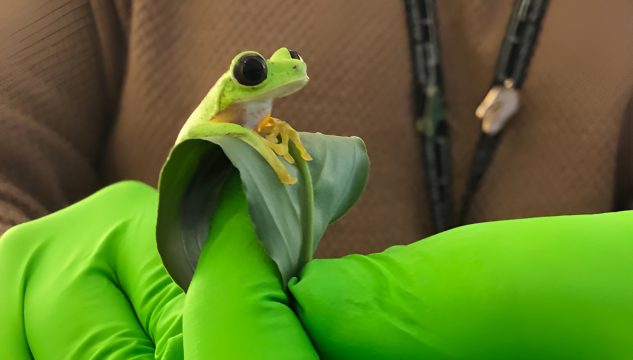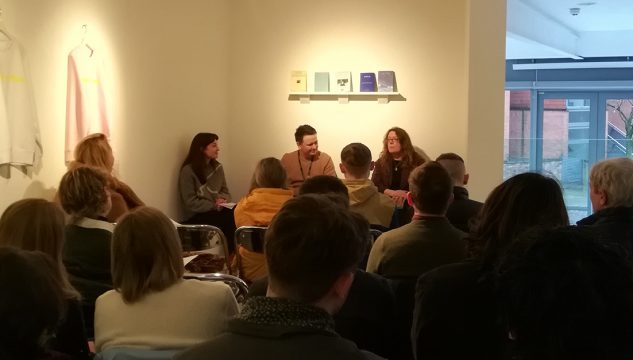-
Frogs, Fertility and Climate Change event at Castlefield Gallery (2023)
-
Talk with Dr Lottie Hosie and Matthew O’Donnell at Castlefield Gallery (2023)
Spotlight: Artists and Sustainability – Elysia Lukoszevieze
Posted on 22 November 2023This month, in our Spotlight – Artists and Sustainability series, where we usually ask artists to share their work and thoughts on how it might relate to climate change, we have decided to ask Creative Producer Elysia Lukoszevieze for her contribution.
Before becoming Manchester Jewish Museum’s Creative Producer, Elysia worked at Castlefield Gallery as the Artist Development & Creative Communities Producer. For over a year, Elysia has programmed some of the gallery’s most successful events, from Jazz Prisciandaro-Wood’s dyes and embroidery workshop to Gregory Herbert’s augmented reality walk around Castlefield. She has also supported emerging artists through our scholars and mentees programme, in partnership with the University of Salford and Manchester Metropolitan University.
In what ways do you feel your work might relate to issues of climate change and sustainability, in the content of the work, its narrative, conceptually or theoretically? How might it speak to or challenge public discourse?
I’m a great believer in bringing voices to the events that I programme and projects that I work on from across varying disciplines, such as academics, community leaders, scientists, researchers, artists, curators and the general public. Ultimately I am interested in the sharing of knowledge through co-creation – rather than a hegemonic approach. By bringing different areas of interest together in a space they give one another new context, art and science often have the ability to do that together.
For example, I programmed a day of events titled ‘Frogs, Fertility and Climate Change’ (or Frog Day as it’s more commonly known) which ran alongside El Morgan’s exhibition, Tale of the Frozen Bits. This day was done with the curator of Herpetology at Manchester Museum, Matthew O’Donnell, who brought some live frogs and amphibians into the gallery for people to meet and learn more about. The day also featured a talk between myself, Matthew and Lottie Hosie – an animal behavioural researcher at Chester University. Both Matthew and Lottie were able to share a huge amount about their research, the effect that climate change is having on amphibians around the world, the Museum’s conservation efforts and also the use of frogs in the development of fertility drugs – a thread that Morgan was exploring in her exhibition. This day gave greater context to the exhibition in the gallery whilst also bringing in new voices and audiences who had never visited before.
Although most of my work does not address climate change explicitly, it’s something that one cannot avoid thinking about. I endeavour to continue to believe that collectivity and community is the only way forward through this crisis, and it’s something that I hope to foster in my practice.
With regards to the materials, processes and techniques you use to produce your work, are there any practical decisions you make with regards climate change and sustainability?
I have only ever worked within small institutions or independently so in regards to materials, budgets have thankfully been restrictive. This has meant being inventive and doing more with less – a step that I feel everyone should take to reduce the waste that can come with producing events. I very rarely use single use products for events and I also try to work with artists or creatives that share a sustainable mindset if they are running workshops or projects.
In general, how do you feel galleries, art spaces, artworks and artists might be able to contribute, what if any role do you feel they can play in a progressive conversation?
Ultimately, this crisis is not an issue that can be solved by the individual, and those in power have quite cleverly framed it as one that can be. We as a society need to adopt a shift in our relationship to one another and to the planet itself. I think a lot of galleries are very good at doing the box ticking and having X amount of exhibitions per year that explore the climate crisis in order to get their Arts Council funding, but ultimately these institutions are in a position to meaningfully engage with the communities that they serve through a shifting of perceptions, sharing of knowledge, taking risks on the artwork they exhibit, and building and fostering relationships with the people that walk into their galleries.
Are there any tips or advice, anything you have learnt you might want to share with other artists or our audiences?
Connect with one another, read, learn, build nourishing relationships, experiment. And go see some frogs.

